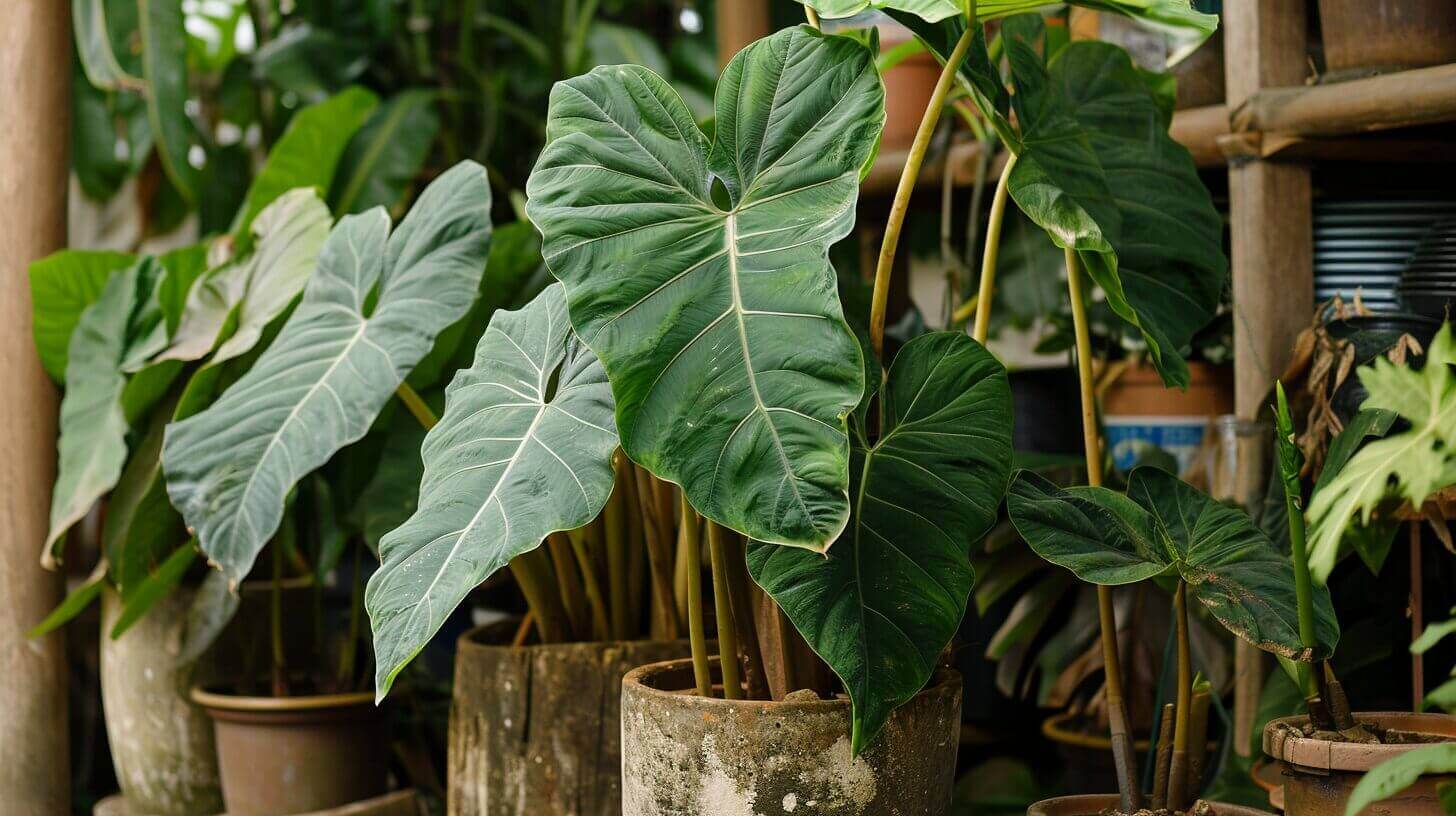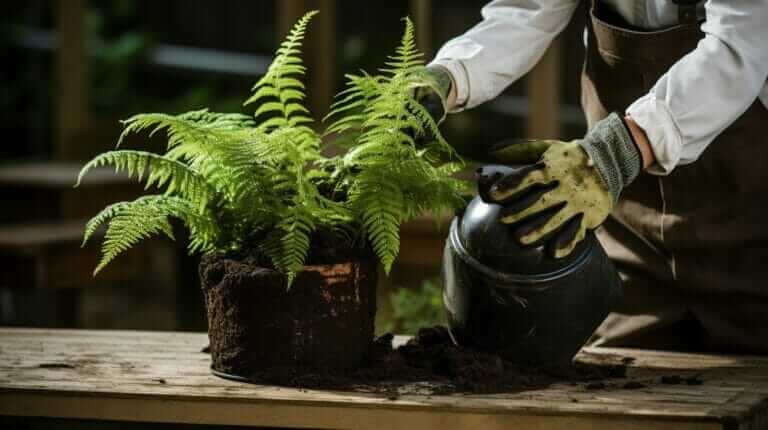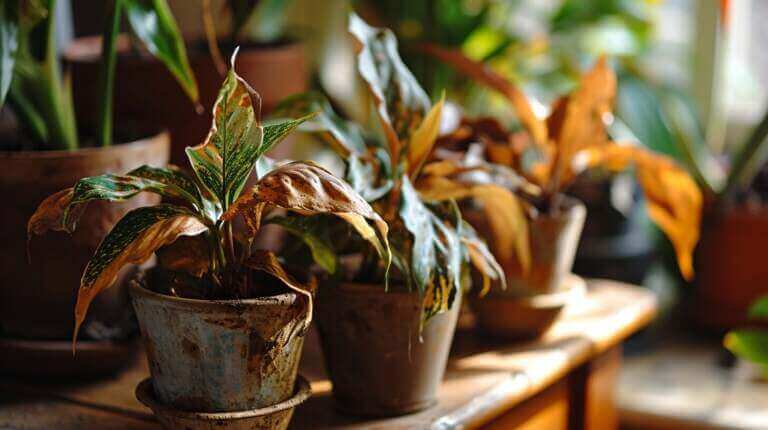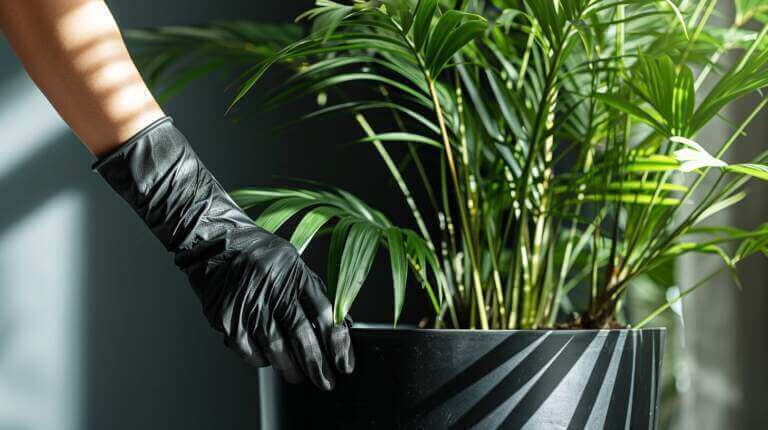What is an Elephant Ear Plant? Grow and Care For Elephant Ear Plant(Colocasia Esculenta)
Elephant ear plants, also known as Colocasia esculenta, are a group of tropical perennial plants prized for their large, heart-shaped leaves. These plants, belonging to the genera Colocasia, Alocasia, and Xanthosoma, are known for their bold foliage and tropical look. Colocasia esculenta, commonly referred to as taro, is one of the most widely grown species and has been cultivated for thousands of years for its edible corms.
Elephant ear leaves can grow up to 3 feet long and 2 feet wide, depending on the species. They are attached to long petioles that come directly from the underground corm. While these plants can bloom, the flowers are not common and are usually hidden underneath the foliage. Elephant ear plants produce globular green or yellow berries.
There are many interesting cultivars of elephant ear plants available, including ‘Black Coral’, ‘Black Magic’, ‘Blue Hawaii’, and ‘Burgundy Stem’. These cultivars feature unique leaf colors and patterns, adding to the appeal of these striking plants.
Key Takeaways:
- Elephant ear plants have large, heart-shaped leaves and belong to the genera Colocasia, Alocasia, and Xanthosoma.
- Colocasia esculenta, also known as taro, is one of the most widely grown species and is cultivated for its edible corms.
- Elephant ear plants can grow up to 3 feet long and 2 feet wide, with leaves attached to long petioles.
- These plants can bloom, but flowers are typically hidden underneath the foliage and produce green or yellow berries.
- There are various cultivars available, showcasing different leaf colors and patterns.
Different Types of Elephant Ear Plants
Elephant ear plants come in a variety of types and cultivars, each with its own unique characteristics. Let’s take a closer look at a few popular varieties:
Colocasia (Taro)
- Colocasia esculenta – Common green elephant ear
- ‘Black Magic’ – Dark black-purple leaves
- ‘Black Coral’ – Near-black leaves with ruffled edges
- ‘Pink China’ – Pink stems with dark green leaves
- ‘Fontanesii’ – Silver-green leaves with dark veins
Alocasia (Tropical Elephant Ears)
- Alocasia ‘Amazonica’ – Large dark green leaves with silvery veins
- Alocasia ‘Polly’ – Compact plant with shiny, pointy leaves
- Alocasia ‘Calidora’ – Wavy-edged leaves emerge bluish then fade
Xanthosoma (False Taro)
- Xanthosoma ‘Lime Zinger’ – Bright chartreuse foliage
- Xanthosoma ‘Green Papaya’ – Velvety green maple-shaped leaves
Other Hybrids
- Colocasia ‘Coffee Cups’ – Glossy black leaves shaped like cups
- Colocasia ‘Mojito’ – Lime green and black freckled leaves
- Colocasia ‘Blue Hawaii’ – Blue-green heavily corrugated leaves
How to Grow Elephant Ear Plants in a Pot
Growing and caring for elephant ear plants is a rewarding experience that allows you to enjoy their bold foliage and tropical look in your garden or as houseplants. Whether you choose to grow them in pots or in the ground, following a few simple care tips will help ensure their health and vibrancy.
Choose the Right Container
Elephant Ear plants can grow quite large, so they need a pot that can accommodate their size. Colocasia species typically need pots that are at least 18 inches wide and 16 inches deep. Alocasia cultivars need pots that are at least 36 inches wide. The container should have drainage holes to prevent waterlogging.
Select the Perfect Spot
Most Elephant Ear plants prefer full sunlight, which means they need six to eight hours of sun each day. However, some varieties grow better in partial shade.
Prepare the Soil
Use a well-draining potting mix suitable for aroids. A mix of 5 parts bark, one part perlite, and one part peat moss is recommended for potted plants. The organic matter holds moisture, and perlite improves drainage.
Watering and Feeding
Elephant Ear plants prefer consistently moist soil to grow to their optimal size. They are heavy feeders, so regular feeding with a balanced fertilizer during the growing season will help them thrive.
Planting and Care
When growing elephant ear plants, it’s important to start with a large bulb or a rooted plant. Plant them in rich, well-draining soil, and provide regular water and fertilizer during the growing season. Plant one tuber per pot about 2 to 3 inches deep. Place your pot in a warm, sunny spot (at least 60 degrees) and don’t water until the sprout shows above the soil.
These plants thrive in moist soil, so make sure to water them consistently to keep the soil evenly moist. Using a slow-release fertilizer or organic compost can help provide the nutrients they need for healthy growth.
If you live in a colder climate, you can grow elephant ear plants in containers and bring them indoors during the winter months. Place them in a sunny spot near a window and continue to water and care for them as usual. Overwintering in a cool, dry location is crucial to protect the plant and ensure its survival until the next growing season.
Propagation and Maintenance
Elephant ear plants can be propagated by dividing the bulbs or planting the smaller tubers that grow off the main corm. This can be done in early spring before the growing season starts. Simply separate the bulbs and tubers, and plant them in separate containers or in the ground. Make sure to provide adequate space for each plant to grow.
To maintain the health and appearance of your elephant ear plants, it’s important to remove any yellow or damaged leaves regularly. This will not only keep the plant looking tidy but will also prevent the spread of diseases. Additionally, keep an eye out for pests such as aphids or spider mites, and treat them promptly with organic insecticides if necessary.
Indoors Care
If you choose to grow elephant ear plants as houseplants, they can add a touch of the tropics to your indoor space. Place them in a location with bright, indirect light, and maintain a consistent temperature between 65-85°F (18-29°C). Keep the soil evenly moist, but avoid overwatering, as it can lead to root rot. Regularly misting the leaves can help increase humidity, which mimics their natural tropical environment.
Keep an eye on the plant’s leaves for any signs of drooping or spots, which might indicate a need for more care. If the leaves start to droop, it might be a sign of too much or too little water.
With proper care and attention, your elephant ear plants will thrive and become an eye-catching addition to your home or garden. Whether you’re a beginner or an experienced gardener, these tropical beauties are sure to impress with their large, statement-making leaves.
Elephant Ear Perennial Plants in the Landscape
Elephant ear plants are a great addition to any landscape, adding a bold and tropical look to your garden. These plants thrive in climates with warm temperatures and high humidity, making them ideal for tropical and subtropical regions. They can tolerate full sun or part shade, but certain varieties, such as the darker colored ones, thrive best in full sun.
One of the main attractions of elephant ear plants is their large, vibrant green leaves, which can create a dramatic contrast in beds and borders. The size of the leaves varies depending on the species, with some reaching up to 3 feet long and 2 feet wide. The leaves are attached to long petioles that come directly from the underground corm, which is the bulb-like structure that stores nutrients for the plant.
Elephant ear plants prefer moist soil and are often found at the edge of ponds or in water gardens. They can also be grown in containers, making them a versatile choice for smaller gardens or patios. Some popular varieties of elephant ears include ‘Black Magic’ with its dark purple leaves, ‘Illustris’ with its black and green leaves, and ‘Lime Zinger’ with its vibrant chartreuse foliage.
Overall, elephant ear plants are a fantastic option for gardeners looking to create a tropical ambiance in their landscapes. With their lush foliage, unique form, and ability to thrive in warm and humid climates, they are sure to make a statement in any garden.
Care Tips To Grow Elephant Ear Indoors
If you’re looking to add a touch of the tropics to your home or garden, elephant ear plants are a great choice. These striking plants can be grown as houseplants or outdoors in warm, tropical climates. To ensure they thrive, here are some care tips to keep in mind:
Provide a tropical environment
Elephant ear plants love the tropics, so it’s important to create a warm and humid environment for them. Indoors, you can use a humidifier or place the plant on a tray filled with water and pebbles to increase humidity levels. Outdoors, make sure to plant them in an area with partial shade to protect them from intense sunlight.
Replant or grow in large containers
Elephant ear plants have a tendency to outgrow their pots quickly, so it’s important to replant them in larger containers as they grow. This will give their roots enough space to spread and allow them to continue growing vigorously. If planting them outdoors, make sure to choose a spot with well-draining soil.
Fertilize regularly
Elephant ear plants are heavy feeders and require regular fertilization to maintain their lush growth. Use a balanced liquid fertilizer once a month during the growing season to provide them with the nutrients they need. Be sure to follow the instructions on the fertilizer packaging for best results.
Overwintering
In warm climates, elephant ear plants can be left in the ground year-round. However, in colder regions, it’s important to dig them up before the first frost and store them in a cool, dry place for the winter. You can wrap the bulbs in newspaper or store them in a breathable container filled with peat moss or vermiculite.
By following these care tips, you can ensure that your elephant ear plants grow to their full potential and provide your home or garden with a lush, tropical look.
FAQ
What is an Elephant Ear Plant?
Elephant ear plants are tropical plants known for their large, heart-shaped leaves. They belong to the genera Colocasia, Alocasia, and Xanthosoma, with Colocasia esculenta being one of the most widely grown species. They are cultivated for their edible corms and are considered an important food crop in tropical regions.
What are the different types of Elephant Ear Plants?
There are various types and cultivars of elephant ear plants, including Alocasia, Calla, and Tuberosa. Alocasia is known for its upright leaves and distinct leaf shapes, Calla produces tuberous growths and has a calla lily-like flower structure called spathe and spadix, while Tuberosa is known for its edible corms and large, palmate leaves.
How do you grow and care for Elephant Ear Plants?
To grow elephant ear plants, start with a large bulb or rooted plant and plant it in rich, well-draining soil. Provide regular water and fertilizer during the growing season to encourage large leaf growth. Elephant ear plants can also be propagated by dividing the bulbs or planting the smaller tubers that grow off the main corm. When overwintering, keep the plant in a cool, dry location and cut back yellow leaves. Fertilize regularly for healthy growth.
Where can Elephant Ear Plants be used in the landscape?
Elephant ear plants can add a bold, tropical look to any landscape. They are best suited for warm climates with high humidity. They can tolerate full sun or part shade, but darker colored varieties thrive in full sun. Elephant ear plants are typically grown for their large, vibrant green leaves, which can create a dramatic contrast in beds and borders. They prefer moist soil and can often be found at the edge of ponds or in water gardens.
What are some care tips for Elephant Ear Plants?
Elephant ear plants are relatively easy to care for. They can be grown indoors as houseplants, but they thrive best in a tropical environment with high humidity. In colder climates, they can be replanted in the ground or kept in large containers. These plants are heavy feeders and require regular fertilization to maintain lush growth. In warmer climates, they can be left in the ground year-round, while in colder regions, they should be dug up and stored during the winter. Elephant ear plants can also be grown as focal points in large containers, creating a tropical look on a deck or patio.







